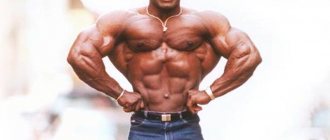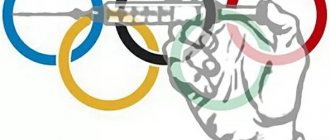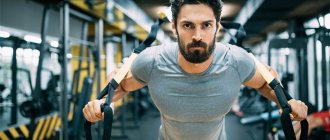About records in pull-ups
Record of 105 pull-ups.
It takes about 10 minutes to do 105 pull-ups. It's like running 3 km.
Pull-ups for a record are not a sprint, but a stayer's run, and therefore do not require large muscle mass.
A record holder in pull-ups is not at all similar to a representative of strength sports, just as a stayer is not similar to a sprinter.
The standard for pull-ups is 12 times, and the record is 105 times.
The standard is 12 times established for people of all weight categories.
And if you ask me what I want more: to do 105 pull-ups with my own weight of 60 kg or to do 12 pull-ups with an additional weight of 24 kg, then I will choose the second one, because it will improve my appearance.
I'm no better than most fat people who can't do 12 pull-ups.
Judge for yourself. My weight is 76 kg. Let's add 24 kg to them. In total we get 100 kg.
How many times can I do pull-ups with a 24 kg kettlebell? How many pull-ups would I do if I were a fat person who weighed 100 kg?
A huge number of overweight people weighing 100 kg can do 8 pull-ups.
With a 24 kg kettlebell I was also able to do 8 pull-ups.
Have you seen my record?
Now I'm wondering how much more lifting I could do if I weighed 100kg in 6 weeks?
What should I do these 6 weeks to get this result?
This is a serious challenge.
What is the body capable of after forty years, if the form is not zero. It's easy to grow from scratch. But how to grow when nature itself says: it’s time to give way to the young, it’s time to retire.
I could do anti-aging treatments, but you'll notice that right away.
If my muscle mass goes up sharply and about five kilograms stick to my bones, then there will be no need for any doping controls - and then everything will become clear.
How much can I change my body properties without changing my shape in 6 weeks?
I don't know, it's a mystery to me.
If you want me to carry out this inhumane experiment on my own skin, then like and write a comment: how many times will I do pull-ups in 6 weeks and what should I do for this?
In future episodes, I will talk about strategies for training record pull-ups and results from week to week.
6 weeks – 6 issues – 6 tips – one result.
This series of 6 issues is a mystery even to me, because I don’t know what exactly I will do and how it will all end. These are not hypotheses of scientific approaches like “do this and everything will be fine.”
This is pure practice with a concrete result. And you will see with your own eyes: what and how it works, not in words, but not in deeds.
Levels and standards in pull-ups
To predict success, you need to assess your level of preparation.
As it turned out, what I planned to do is called multi-repetition streetlifting.
As in any sport in Russia there is a table of standards.
According to this table, it turned out that I fulfilled the standard of the second category.
To fulfill the first category standard, I need to pull myself up not 8, but 12 times.
In the USSR, normative grids were written with the expectation that the average person could make the transition from one category to another in one year.
I am pleased that you appreciate me and believe that I will double my results in 6 weeks.
But statistics from a sport like streetlifting say that half of this result is the goal of one year, not six weeks.
Being able to make a forecast is an important part of motivation.
If you don't know the tools for calculating your target, you will miss and get frustrated. A miss is very demotivating.
This is not an idle question.
If I can theoretically add 4 reps in one year, how much can I add in 6 weeks.
Arithmetically, this is a problem for a second grader. And how to solve this problem physiologically according to the rules not only of mathematics, but also from the point of view of adapting the aging body to changed environmental conditions.
Even arithmetically, 4 repetitions per year is one repetition per quarter.
To increase my record by one repetition, theoretically it would take me not 6 weeks, but 12 weeks.
Will you wait 12 weeks on my channel to watch me do nine pull-ups instead of 8?
Such a goal can even deprive you of motivation to watch, let alone me to train.
What goal should I set for 6 weeks so that I believe in it, at least theoretically, and you want to wait for it with interest?
For most people, theory is needed to get started.
For example, most people, in order to cut carbohydrates, need the theory of the Atkins or Dukan diet, which, in scientific language, by introducing the terms insulin and ketosis into the housewife’s brain, encourages an overweight woman to put a piece of cake aside.
The phrase “don’t eat cake and lose weight” doesn’t work from a motivational point of view.
How to apply
To get a rank in street workout, write down each stage of completing all tasks on an electronic medium. After all the elements have been recorded, edit them in any, even the simplest video editor.
The quality of the recording for passing the standards is not the main thing. The main thing is that there is enough light on the site, the expert must see the details of the complexes being performed. Don't go overboard with the zoom. The participant must be photographed at full height.
Next, post the recording on the official website. Here, experienced experts will evaluate the implementation of the complex, and if everything is done correctly, the video will be placed in the rating table, and you will receive a rank.
There are no time restrictions to receive a shock; there is no need to perform the complex at the same time. Nobody is rushing anyone, complete the complex for several days, and then mount them into a single file. If you do not have video editing skills, you can contact agencies or freelance exchanges.
After viewing the video submitted by the athlete, the judges make their decision. The luminaries of street gymnastics evaluate the correctness of all exercises and elements. The names of the best are entered into a single list of dischargers. This information is publicly available. Entry into the register confirms the fact that certain standards have been passed.
Prediction for success in pull-ups
To predict your result, you first need to assess your level of preparation.
For example, in polyathlon pull-ups today I don’t even reach the third category, but in streetlifting pull-ups I showed the level of the second category.
What should I do to move from the second tier level to the first tier level.
I should improve my score by 50%.
But if my level of training had been higher, for example, I would have shown the level of the first category, then moving to the next level - the CMS level - would require me to increase only 13%.
It is unofficially believed among coaches that the transition from the second category to the first requires a year of training, and the transition from the first category to the CMS requires two years.
Amazing, right?! An increase of 50% of the result requires a year of training, and an increase of 13% of the result takes two years.
In any sport, there are training programs for different skill levels.
For example, the training program for junior runners is very different from the training program for elite runners.
If for junior ranks it is enough to run 80 km a week, then masters of sports run 200 km.
In any sport, training programs have mathematical modeling based on the training statistics of a large number of athletes from past years.
When it comes to backyard sports such as street lifting or basement sports such as bodybuilding exercise equipment, among teenagers and gymnasts, mathematical modeling of training causes misunderstanding at best, and ridicule at worst.
Despite the fact that the yard and basement culture has devalued mathematical modeling of training, I would like to gently tell you how the experience of weightlifting and running - Olympic sports in which mathematical modeling is developed, could help a yard or home athlete improve your performance in pull-ups depending on your level of training.
Friends, take the time to evaluate your level of preparation.
If you cannot do 21 pull-ups, then your level of training is below the third category. In sports, such athletes are called b/r - without category.
If you do more than 21 pull-ups one time, then try doing pull-ups with a 16 kg kettlebell.
If you weigh more than 75 kg, then for the third category you need to pull yourself up more than 7 times.
VII Category (MS in workout)
Base:
1) Pull-ups - 40 2) Push-ups on parallel bars - 60 3) Push-ups from the floor - 85 4) Raising straight legs while hanging on a horizontal bar (toes touch the bar) - 35 5) Push-ups in a vertical handstand against a wall - 25
Elements:
1) Pull-up with a force of two - 25 2) Horizontal support on straight arms (level legs together) - 3 seconds 3) Push-ups in a horizontal support (level legs together) - 5 4) Pull-ups on one arm (without jerking) - 7 (on each arm) 5) Horizontal hang from the front – 10 seconds 6) Horizontal hang from the back (“swallow”) – 25 seconds 7) Pull-up on one arm in the “towel in front” (on each arm) – 1 8) Horizontal support under the horizontal bar – 15 seconds 9) From the horizontal support under the horizontal bar (3 sec) forcefully lower into a horizontal hang from behind (6 sec) 10) Angle under the horizontal bar in a narrow grip – 15 seconds 11) Flag – 15 seconds
What is the pull-up technique like?
Online advisors on the topic “how to do more pull-ups” most often recommend training to failure.
In decent sports, competitions are held once every six months and therefore a competitive approach is a rare phenomenon.
Having experience training in sports sections and experience experimenting with non-traditional methods of improving body properties, I am inclined to choose traditional training methods.
If I decided to prepare for a competition approach for six weeks, then during this period I will only do training approaches.
What does high-repetition street lifting look like? What kind of sport is recognized throughout the world, or better yet, is it an Olympic sport?
It is difficult to find an analogue in strength sports.
Powerlifting is a one-rep max competition, not a multi-rep max event.
Kettlebell lifting is not a strength sport, but a cyclic sport, because the competitive approach lasts 10 minutes.
High-repetition street lifting is similar to the traditional bench press. But the national bench press is still a young sport, which itself is in its infancy and has no idea how to develop.
However, people in the folk bench press gather older people than in street lifting, so they approach the issue wiser.
People's benching has already figured out that they need to look more at 400-meter runners than powerlifters.
400-meter runners have more in common with the folk press and high-rep street lifting than strength sports.
And this is common - special strength endurance, which in running is called speed endurance.
Strength endurance and speed endurance combine the concepts of lactate power and lactate capacity.
size/quarter training, I have acquired sufficient lactate capacity, but I have not trained the lactate capacity of the upper extremity muscles for a long time.
I must make up for this deficiency in 6 weeks of preparation.
Both the strength endurance of streetlifters and the speed endurance of runners are submaximal power work.
Glycolysis provides submaximal power work in muscles.
Glycolysis unfolds in 20-30 seconds and can last up to 5 minutes depending on the level of training.
That is why in polyathlon the time for pull-ups is limited to 4 minutes.
If you watch the first episode of my inhumane experiment, you will see that I did the first 7 pull-ups in 21 seconds and hung.
This suggests that when glycolysis unfolded, it turned out that I did not have lactate capacity.
Why are they useful?
Streetlifting / training program
The beneficial effects of pull-ups significantly outweigh the possible harm from this exercise:
- the work of the musculoskeletal system is stimulated. The child’s muscles become trained, the skeleton becomes stronger and the likelihood of bone fractures decreases;
- endurance increases, which is especially important for those who go to sports clubs or lag behind their peers in physical education lessons;
- the cardiovascular system is strengthened, the volume of the heart muscle increases;
- the immunomodulatory effect of this exercise allows you to become healthy and resistant to infectious and colds;
- the overall physical fitness of the baby improves. A child who pulls up his body weight can easily do push-ups from the floor and parallel bars, master a handstand and walk on his hands;
- excess weight decreases, adipose tissue turns into muscle;
- Correct posture is formed, and a beneficial effect is exerted on the vertebrae and intervertebral discs.
We advise you to learn about a set of stretching exercises for children.
Pull-up training aids
In sports there is the concept of “training aid”.
Good coaches have only one goal in every workout.
The goal of training is to develop only one quality that helps improve results.
Pull-ups require strength, strength endurance and technique.
Focusing on one goal or one quality is very important because the brain can only have one point of attention.
Shooters know that only movie characters can shoot with both hands. Try throwing two basketballs into two baskets with both hands at once.
So: one workout - one goal.
What do I want? I want to do 12 reps with a 24kg kettlebell.
What I can? I can do pull-ups with a 24kg kettlebell 8 times or without a kettlebell 20 times.
I need to develop strength, strength endurance and improve technique.
To develop strength, I train with a 32 kg kettlebell for 3-4 repetitions.
To develop strength endurance, I train without a kettlebell for 9-10 reps for 15 sets or 18-19 reps for three.
I do workouts of 9-10 repetitions to develop a base of strength endurance.
And approaches of 18-19 repetitions for the development of volitional qualities.
Volitional qualities in sports and volitional qualities in a healthy lifestyle are diametrically opposed things. I wrote about strong-willed qualities in a healthy lifestyle in the training manual “Convinced Healthier.” Link in description.
I also constantly watch videos of my pull-ups and compare them with the techniques of record holders, trying to understand where I lose and where they save strength.
And of course, in order to accustom my body to a competitive approach with a weight of 24 kg, I do pull-ups with a 24 kg kettlebell.
So, 4 types of training to improve the result in pull-ups with a 24 kg kettlebell at the second category level:
Pull-ups with a 32 kg weight – 3-4 repetitions. Pull-ups with a 24 kg weight – 5-6 repetitions. Pull-ups to develop strength endurance without weights, 9-10 repetitions. Pull-ups for the development of volitional qualities, 18-19 repetitions.
All that remains is to understand how many approaches to do in each of these workouts and how many such workouts to do per week.
VI Category (CMS in workout)
Base:
1) Pull-ups - 35 2) Push-ups on parallel bars - 50 3) Push-ups from the floor - 70 4) Raising straight legs while hanging on a horizontal bar (toes touch the bar) - 30 5) Push-ups in a vertical handstand against a wall - 16
Elements:
1) Exit with force for two – 20 2) Horizontal support on straight arms (straight legs apart or together) – 3 seconds 3) From the horizontal support under the horizontal bar (1 sec) force yourself down into a horizontal hang from behind (3 sec) 4) Horizontal push-ups ( straight legs apart or together) – 3 5) One-arm pull-ups (without jerking) – 5 (on each arm) 6) One-arm pull-ups in a “towel in front” (on each arm) – 1 7) Horizontal front hang – 6 seconds
Pull-up training volume
Before breaking down your weekly training plan into training days, you need to calculate your weekly training volume.
For example, in weightlifting, the weekly volume of training is measured in KPS - the number of lifts of the barbell or in tons, and in athletics in kilometers.
Athletes of the level of an international master of sports run more than 200 km per week, and weightlifters manage to do up to 150 lifts of a barbell weighing more than 90% of their personal best in a week.
How should I measure my training volume? In the size/quarter , I measured workouts in sets. This was enough for dull muscle growth.
However, pull-ups for results are more difficult. Here I will have to take into account the number of pull-ups per week, and the number of approaches, and tonnage, because this is not weightlifting, where only strength is measured, and not athletics, where endurance is important.
Here the mathematical model is a little more complicated, because I need to take into account the volume of training for both strength and endurance.
As a result of analyzing the workouts of the first week, I found an error. And if I don’t correct this error at the very beginning, then in the end I won’t get the declared result within the agreed time frame.
In one week I managed to do 77 sets of pull-ups alone. This is a good amount of training to start with, although it equates to approximately 2.5-3 hours of training time.
To move from the second category to the first, you need to work at least 5 hours over the course of a year. This is 150 approaches per week.
In just one week, I only did 602 pull-ups. So far this indicator doesn’t mean anything to me, but it needs to be increased.
Also, a week before the crossbar, I pulled 52 tons. This indicator must be increased while maintaining intensity.
This is the basis of strength training!
So there are three parameters for training volume:
Approaches; Repetitions; Tons
Now you need to derive the training intensity from this volume.
But how should intensity be expressed? In kilograms or in repetitions per set?
Document
To become a CCM, you need to pass standards, train hard and maintain discipline; you will also need success and certain achievements in the professional field. If the athlete successfully goes through all this, then he is given a special, officially issued document. Such a certificate is called a “crust”. Upon achieving this title, the athlete reaches a completely new level.
Next comes the Master of Sports. The most significant and highest level in the field of sports is the international master of sports (MSMS). The prestige of an athlete directly depends on his rank.
Pull-up training intensity
In any sport, the intensity of competition is taken as 100%.
If health training allows 60% of competitive intensity, then sports training should take place at a level above 80%.
High level athletes only consider training above 90% intensity.
In my experiment, I showed an intensity of 8 pull-ups and 100 kg.
If I take intensity from repetitions, then my workouts should be done with a load of 6-7 repetitions per set with a 24 kg kettlebell.
In principle, this training model is enough to naturally increase results.
So, a simplified training model is 25 sets per week of 6-7 repetitions per set with a 24 kg kettlebell.
But it's better to do 7 repetitions. It will be more reliable this way.
If by the end of the experiment I can increase the load to 9-10 reps per set for at least 25 sets per week, then I can hope for 12 pull-ups per competition set.
On the other hand, I can approach the issue through the weight that I pull towards the bar.
My body weight is approximately 75% of the competition weight that I will need to pull to the bar.
And if I do more than 12 pull-ups in each of 25 sets per week, then there is hope for an improvement in the result with a 24 kg kettlebell.
The trouble is that I'm an ordinary person and I don't live in a gym. And I don’t always have a horizontal bar with a 24 kg weight on hand.
To progress with the kettlebell, I need 5 workouts per week for 5 sets. But I go to the gym 1-3 times a week.
I will be forced to do some workouts casually on the street without weights.
In order to somehow maintain the volume and intensity of my pull-up training, I have to do pull-ups with my body weight more than 12 times per set.
The final training model, taking into account everyday problems with access to sports equipment, is:
25 approaches with a minimum of 24 kg kettlebell 7 times or without a kettlebell more than 14 times per set.
Of course, approaches with a weight are valued higher, but in the absence of a weight, you must definitely do pull-ups at least without a weight but with a large number of repetitions.
How many times should you do push-ups?
Many athletes are interested in the parallel bars push-up schedule for beginners; we recommend adhering to the following scheme:
- Start the program with two sets of 10 reps. Exercise every other day so that your muscles have time to rest;
- If you feel that the execution is easy, increase the number of repetitions by 5 push-ups;
- After a week, you can increase the number of approaches to 3.
After a month, you should do 4 sets of 30 push-ups, no less. Starting from the second month, you can do push-ups on the uneven bars every day. Additional weight is added when the load is no longer felt much. Add no more than 5 kg each time.
If you don't know how to start doing dips from scratch, first pump up the target muscles with standard push-ups. The body must be ready for increased stress, otherwise everything will end sadly for you.
Remember, the answer to the question “how many times should you do push-ups on the uneven bars” will be individual for each athlete. This depends on his level of physical fitness, the condition of the target muscles, age, emotional state, etc. The diagram we have given is approximate, and there is nothing terrible in the fact that you slightly adjust it to suit yourself. The most important thing is to study systematically and without skipping. And don't stop there.
Pull-up grip width
From the very beginning, you need to decide which muscles to focus on.
The load on the muscle group will depend on the grip width.
If you evaluate the beauty of my body from a bodybuilding point of view, my biceps are far behind my latissimus dorsi. So I will bet on the lats and wide grip.
In polyathlon, the permissible grip width is 80 cm.
I am not tall and my arms are short. If I were a dog, I would probably be a dachshund.
What grip width should a dachshund have in pull-ups?
A grip that is too wide creates unnecessary tension in the forearms.
After much experimentation with grip width, I found a width that was comfortable for me, when the load was taken by the latissimus dorsi muscles, but without overloading the forearms.
For my height, arm length and the ratio of development of the lats, biceps, and forearms, the optimal grip width turned out to be about 70 cm.
People often ask which grip is best for doing pull-ups. As you can see, this is an individual question and depends on height, arm length, place of attachment of muscles to bones and training experience.
For example, in weightlifting, my back muscles were loaded 5 times a week, but we were not allowed to train our biceps.
Why would I now focus on biceps if I have been forced to train my back since my youth?
In addition, the attachment points of my biceps to the bone are not in the most favorable position. But the triceps took an advantageous position.
This is how I differ from Schwarzenegger.
Schwarzenegger loved to show off his biceps from all angles. But have you ever seen a photo of Arnold showing off his triceps with his arms crossed behind his back in the classic side triceps pose?
This is our nature: advantages are compensated by disadvantages.
My gains in one-arm push-ups and bench presses are offset by my lack of bicep strength.
Therefore, I focus on a grip wider than the shoulders and the latissimus dorsi muscles.
Moreover, my shoulders are very narrow. Between my shoulder joints I have only about 40 cm. And my grip is 70 cm.
My grip is 75% wider than shoulder width. This is wide enough to take the stress off the biceps and transfer it to the lats without overloading the forearms.
Tips for implementation
Sets and reps
To develop strength endurance, perform 20-25 repetitions with a weight of 50-60 percent of the maximum. Quickly rise to the bar and slowly descend to a hanging position.
Working for mass means performing with a weight of 70 - 80 percent of the maximum weight. You need to go up to the bar slowly and go down quickly.
Larger weights will help improve strength, 85 - 95 percent of the maximum weight for 2 - 4 repetitions. Rest for at least 3-4 minutes.
As you perform, concentrate on the tension in your back. Bring your shoulder blades together as much as possible and try to touch the horizontal bar with your chest. Record a video and analyze what technical mistakes you make.
What weight to choose
For the first week, limit your weight to 5 kg. As you progress through the programs listed in the “Training Examples” section, increase the weights by three kilograms. Focus on your own feelings to prevent overtraining.
Position of body parts
During push-ups on the uneven bars, you need to monitor the position of body parts:
- Shoulders. They are in a stable position and should not “walk.”
- Wrists. The optimal grip is shoulder width apart.
- Elbows. Throughout the entire exercise, you should be pressed to the body, at the top point of the movement - extended as much as possible.
- The spine should be straight.
- Legs. The legs are joined together, the buttocks and thighs are tense. Legs can be bent at the knees, toes extended or bent (depending on the availability of space).
- Core muscles. All muscles are tense and must create a rigid corset during all phases of the exercise, especially when lifting.
PHYSICAL EDUCATION STANDARDS FOR 9TH GRADE STUDENTS:
| Control exercise | unit | boysrating"5" | boysrating"4″ | boysrating"3″ | girls rating"5" | girlsrating"4″ | girlsrating"3″ |
| Shuttle run 4*9m | seconds | 9,4 | 9,9 | 10,4 | 9,8 | 10,2 | 11,0 |
| 30 meter run | seconds | 4,6 | 4,9 | 5,3 | 5,0 | 5,5 | 5,9 |
| 60 meter run | seconds | 8,5 | 9,2 | 10,0 | 9,4 | 10,0 | 10,5 |
| Running 2000 meters | min:sec | 8:20 | 9:20 | 9:45 | 10:00 | 11:20 | 12:05 |
| Standing long jump | cm | 210 | 200 | 180 | 180 | 170 | 155 |
| High bar pull-up | number of times | 11 | 9 | 6 | — | — | — |
| Flexion and extension of the arms in a lying position (push-ups) | number of times | 32 | 27 | 22 | 20 | 15 | 10 |
| Seated Forward Bend | cm | 13 | 11 | 6 | 20 | 15 | 13 |
| Lifting the torso for 1 min of the lying position | number of times | 50 | 45 | 40 | 40 | 35 | 26 |
| Cross-country skiing 1 km | min:sec | 4:30 | 4:50 | 5:20 | 5:45 | 6:15 | 7:00 |
| Cross-country skiing 2 km | min:sec | 10:20 | 10:40 | 11:10 | 12:00 | 12:45 | 13:30 |
| Cross-country skiing 3 km | min:sec | 15:30 | 16:00 | 17:00 | 19:00 | 20:00 | 21:30 |
| Cross-country skiing 5 km | min:sec | excluding time | excluding time | excluding time | — | — | — |
| Jumping rope in 25 seconds | number of times | 58 | 56 | 54 | 66 | 64 | 62 |
TECHNIQUES FOR FOLLOWING SOME STANDARDS:
Shuttle run 4*9m Bending and extension of the arms in a lying position Lifting the body in 1 minute from a lying position Bend forward from a sitting position
Discussion on the forum (comments:
31
)
Article added: 2015-03-23
| Table of standards for physical education (grades 5-8) Educational standards for physical education for students in grades 5, 6, 7, 8. Table of standards for physical education (grades 1-4) Educational standards for physical education for students of grades 1, 2, 3, 4 classes. GTO standards for schoolchildren, table of standards Table of GTO standards for schoolchildren (boys and girls), for 2022 GTO standards for schoolchildren 16-17 years old (5th level) Table of GTO standards 2022 for schoolchildren (boys and girls 16 and 17 years old) GTO standards for schoolchildren 13-15 years old (4th stage) Table of GTO standards 2022 for schoolchildren (boys and girls 13, 14 and 15 years old) How many calories are burned when walking (calculator) How many calories are spent when walking - online calorie consumption calculator |
How to learn to do more pull-ups on the horizontal bar in a month
≡ April 8, 2013 · Category: Health and beauty A A A
Hello friends.
Before getting to the point, I want to tell you a story from my school life.
It was in grade 6-7, I don’t remember exactly. We had physical training and everyone passed the standards for pull-ups. And at that time I not only didn’t like to do pull-ups (due to excess weight), but I also didn’t know how.
And so I go up to the horizontal bar, pull myself up with difficulty once, then barely a second time and that’s it! I can not anymore! Thank God that no one at least laughed at me at that moment, but it was still embarrassing. In general, you became unbearably ashamed, do you know after what?
A little digression: What do you think this girl in the picture above is thinking about? I think she’s thinking: “I wonder how many pull-ups he can do?” Well that's just a joke
How is the level reflected?
All sports titles and categories are a kind of recording of the athlete’s achievements in the field of sports, as well as the achievement of a specific level. Every athlete, not just professional ones, is proud of such achievements. Not all athletes reach such ranks, otherwise they would not exist at all. The title of candidate master of sports today is the last step before achieving the most significant and respectable titles - “master of sports”, “honored master of sports”, “international master of sports”. Everything is similar with discharges.
For most athletes, and especially for boxers, title and rank are always very desirable. Moreover, most prestigious competitions allow boxers who already have a CCM. Consequently, this title is just a big step towards the name dropping one letter and together KMS transforming into MS (Master of Sports).
If an athlete has achieved at least the first category, this means that he has talent. However, new titles and achievements are not earned by talent alone, so you will have to be patient and work hard in training to achieve the best result. Signs of growth include prizes and medals in competitions at various levels.
Elements
Exit by force. It is performed with one hand, without additional swinging, and also without unnecessary jerking of the legs. At the top, you need to straighten your arms.
Lifting by revolution. When performing an inversion lift, the legs are positioned straight, and when pushing at the top, the arms must be straightened.
Captain's rise. It is performed by forceful tension, but not by rocking the pelvis. The legs are in a straight state. After completing the approach, you need to go into a squat.
Angle on the horizontal bar. When doing the corner, keep your legs straight, at an angle of 900.
Exit with force on both hands. This task is performed with both an upper and lower grip. Narrow and wide grip possible. The arms are fully straightened when fixing the lower and upper levels. The transition to the top point is made simultaneously with both hands.
Martin. The body is kept straight, the grip is shoulder-width apart. Both underhand and overhand grips are possible. Legs are straight, brought together.
One arm pull-up. To perform this task efficiently, the main requirement must be met: the chin must be higher than the crossbar of the horizontal bar. While fixing the bottom point, the elbows should be fully straightened. It is not allowed to swing, touch the ground with your feet, jerk, or push off the ground.
Horizontal hang. When performing a horizontal hang, the body must be kept level, parallel to the ground. Hands clasp the crossbar shoulder-width apart, while legs are brought together, they cannot be bent.
Two-handed exit with a corner. Before starting the lesson, you should fix your body in an angle that should be 900. You should pull yourself up slowly, for at least three seconds. After fixing the top point, you need to straighten your arms in support. During the transition to the lower position, your arms can be slightly bent.
Towel in front. While performing the “towel”, the second hand is positioned straight. Before starting, the body weight is transferred to the free hand, and then a point-blank exit is made. Next, the body is fixed, while the arms are in a level position.
Horizontal stop. When performing a horizontal emphasis, depending on the level of difficulty and, accordingly, the requirements for the discharge being performed, the arms can be placed straight or in a bent position. If you are allowed to bend your arms, then your legs must be kept straight. For the sixth category, keep your arms straight and legs apart. For the seventh category, the arms are held straight, while the legs are brought together.
Power rotation forward. This rotation is performed only by force, but not by swinging the legs until the task is completed.
Checkbox. When performing the element, the body is parallel to the floor. You should hang sideways. The flag is performed on any sports equipment with the possibility of vertical hanging. Hands are straight.











